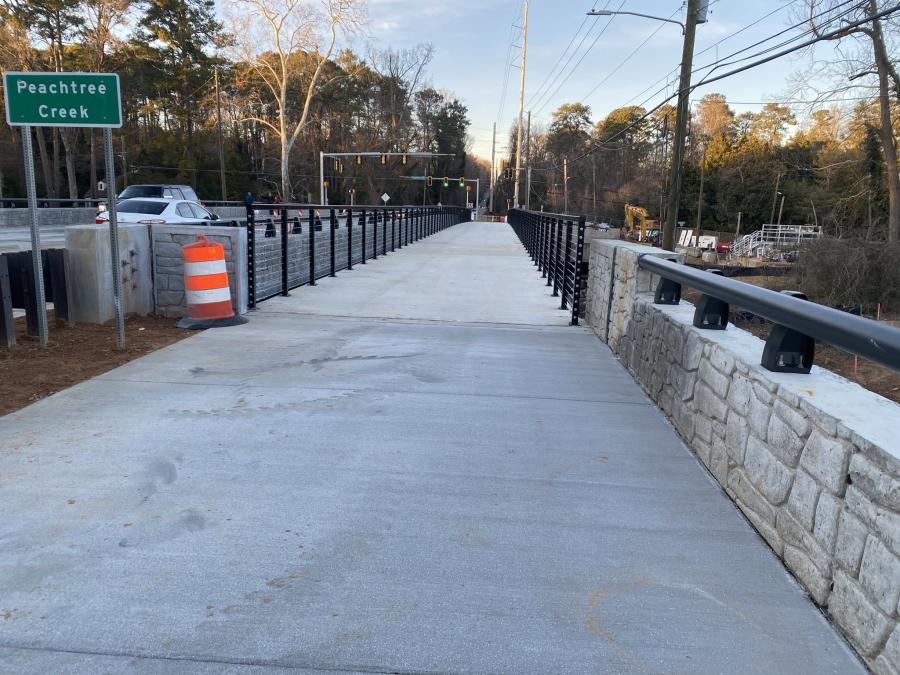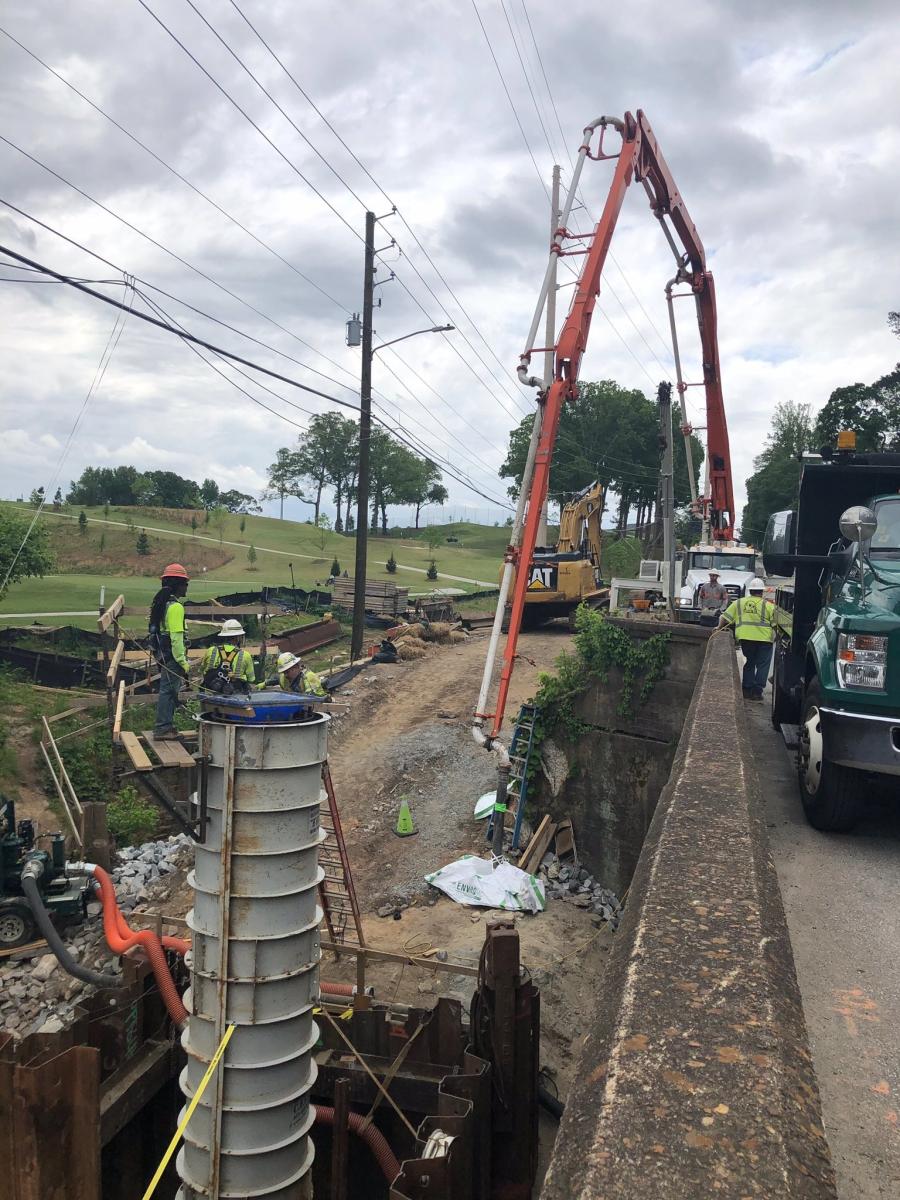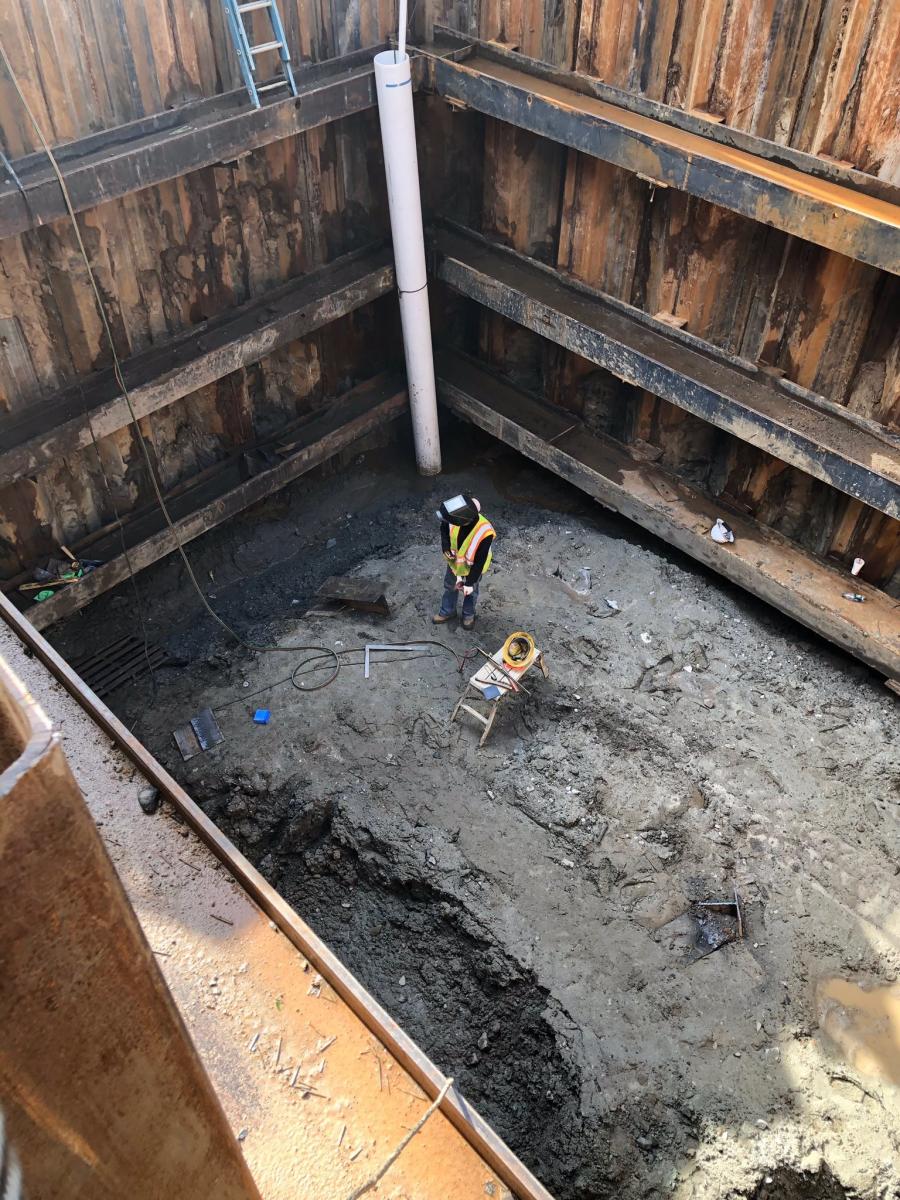Initial planning for the project started in 2007 with preliminary engineering studies, followed by right-of-way purchases in 2018 ($1,250,000) and utility relocations in 2019 ($2,643,529.73).
The Peachtree Creek Bridge on SR 3/Northside Drive in North Atlanta (Fulton County), built in 1926, is being replaced by the Georgia Department of Transportation (GDOT) via a $20,164,623.92 contract that was awarded to C. W. Matthews Contracting Co. Inc. (CWM).
The aging structure over Peachtree Creek has been reconstructed with a new utility/pedestrian bridge on Northside Drive at a total project cost of $25.6M — project engineering, right-of-way purchases and utility relocations. The work includes a new 15-ft. wide utility/pedestrian bridge on the east side of the new Peachtree Creek bridge.
Thus far, nearly 90 percent of the construction has been completed. The work began in March 2019 with extensive vegetation removal and utility relocations. The current anticipated completion date is August 2021.
"Northside Drive serves as a connector for north-south travel in North Atlanta," said Tori Brown, GDOT's District 7 communications specialist. "It is located in a community with many historic resources, including the Atlanta Memorial Park, Woodfield Historic District, Spring Lake Historic District, Haynes Manor Historic District and the historic Bobby Hones Golf Course. The road on either side of the bridge is abutted by historic homes, schools and religious institutions, and it is a heavily travelled corridor serving residents, commuters, cyclists, pedestrians and transit."
The new bridge accommodates high vehicular, pedestrian and bike traffic. The old bridge had outlived its useful lifespan and the new one was designed to meet modern standards.
"GDOT routinely conducts studies to determine the adequacy and integrity of the bridges and we identified the bridge over Peachtree Creek for replacement," said Brown. "There were significant cracks in the bridge piers, abutments and deck. Scour to the streambed negatively affected the integrity of the bridge, and they were likely to continue to worsen. Additionally, having been constructed in 1926, this structure was not designed to accommodate the size and weight of present day vehicles."
The old bridge had a sufficiency rating of 41.29 out of 100. A GDOT document prepared for a March 2015 public meeting stressed that "the option of not acting to replace the bridge in the near future is not prudent."
The old bridge was 125-ft. long and consisted of two 10-ft. lanes with a 10-ft. left turn and a 5-ft. barrier separated sidewalk on the western side, along with an approach of two 10-ft. lanes with historic granite curb and a 10-ft. two-lane left turn (TWLTL) The new bridge, 210-ft. long, has two 10-ft. lanes separated by a 10-ft. TWLTL, with a 2-ft. wide border. It also will have a bike lane and a sidewalk on the western side and the multi-use path on the eastern side of the bridge.
"These paths will connect the existing paths at the Atlanta Memorial Park, Haynes Manor Park and the proposed multi-use path along Bobby Jones Golf Course," said Brown.
The speed limit on the new bridge will be 35 mph.
The work zone, 0.17 mi., begins at the Springlake Historic District, across the street from the golf course, and ends at the Ahavath Achim Synagogue, across the street from the Haynes Manor Historic District. The bridge is situated in the middle, next to Woodward Way and Sagamore Drive.
Initial planning for the project started in 2007 with preliminary engineering studies, followed by right-of-way purchases in 2018 ($1,250,000) and utility relocations in 2019 ($2,643,529.73).
The new bridge, based on a AASHTO LRFD 7th Ed. Bridge Design, was designed by GDOT Bridge Office.
"This project employed numerous bridge construction techniques such as precast deck panels, UHPC (ultra-high performance concrete), micropile foundations, and two-hour ready mix concrete," C. W. Matthews Contracting Co. said. "This is all part of the ABC [accelerated bridge construction] concept, which allowed CWM to complete the bridge within the 90-day closure. "The ABC concept allowed CWM to construct the bridge in a fraction of the time by eliminating waiting periods between construction elements and allowing an ‘around the clock' type schedule."
To minimize the construction impacts on the busy section of road, GDOT has worked cooperatively with area residents, businesses and local elected officials to make them aware of upcoming traffic impacts and address concerns.
"In addition to the busy traffic on Northside, a state route, the project is located at a five-legged intersection leading to neighborhoods on the city street grid, warranting coordinating with COA," said Terrance Cooper, GDOT's project manager. "In addition to some daytime single lane closures on Northside, the primary impact of the project involved a 90-day closure of a portion of Northside while contractors demolished and replaced the Peachtree Creek bridge, removed and relocated utilities on the utility/pedestrian bridge. The scheduling of this extended closure was communicated widely and often with the project stakeholders. As Northside is also an exit off I-75, a detour was installed to eliminate all but local traffic in proximity of the project during the 90 days.
C. W. Matthews Contracting has completed the following elements: the pedestrian bridge, the road bridge, seven retaining walls, sections of new roadway and new drainage/waterline infrastructure. The remaining work consists of the construction of the Woodward Way pump station, Woodward Way east and the utility path tiepin on Woodward Way.
"Working in tight proximity to traffic and high pedestrian volume [was a challenge]," stated CWM. "Efficient use of lane closures, proper signage and constant communication with local stakeholders and GDOT were all key elements to the successful completion of this project."
The demolition of the old bridge consisted of saw cutting and removing the deck in large sections to prevent rubble from falling onto the creek.
"These pieces were lifted off the bridge using a large crane," stated CWM. "Two large rock jetties were constructed on either side of the creek bank in order to demolish the old bridge piers using large backhoe hammers. No real challenges were encountered during this work other than mother nature — a tropical storm. Demolition took approximately seven shifts from start to finish."
CWM's management team includes Project Manager Juan Velasquez and Superintendent Steve Aponik.
Peak days have had 60 CWM and subcontractor employees, with the key subcontractors being Ruby Collins and Robert Kelly Construction.
The excavation and bridge demolition should generate 3,000 tons of asphalt, 550 tons of concrete, steel (the amount has not been tallied), and 250 tons of earth and rock. New materials being brought in will include 2,000 tons of asphalt, 2,350 tons of concrete and 300 tons of steel.
"All of excavated earth and rock was utilized on common fills," stated CWM. "Recycling is important and emphasis is always placed on trying to reuse as much material as possible."
Additional equipment on-site includes: five cranes, eight excavators, three dozers, two loaders, three rollers, two pavers and three skid steers. The manufacturers include Cat, Link Belt, Liebherr, RoadTec and Hamm.
"CWM employs 24/7 on-call mechanics, as well as daily maintenance/servicing on our equipment," stated CWM. "This is normal on all CWM projects and it ensures zero downtime due to equipment failure."
C.W. Matthews purchases and rents equipment from regional and local dealerships.
Along with Cooper, GDOT's team consists of Senior Inspector Selby Cordner and inspectors Demetrius Gibson, Adebayo, Farida, Charles Chapman and Price Aristilde.
"Doing the 90-day closure, different members of the D7 Area Office helped on the project because the demanding schedule," said Cooper. CEG
Irwin Rapoport
A journalist who started his career at a weekly community newspaper, Irwin Rapoport has written about construction and architecture for more than 15 years, as well as a variety of other subjects, such as recycling, environmental issues, business supply chains, property development, pulp and paper, agriculture, solar power and energy, and education. Getting the story right and illustrating the hard work and professionalism that goes into completing road, bridge, and building projects is important to him. A key element of his construction articles is to provide readers with an opportunity to see how general contractors and departments of transportation complete their projects and address challenges so that lessons learned can be shared with a wider audience.
Rapoport has a BA in History and a Minor in Political Science from Concordia University. His hobbies include hiking, birding, cycling, reading, going to concerts and plays, hanging out with friends and family, and architecture. He is keen to one day write an MA thesis on military and economic planning by the Great Powers prior to the start of the First World War.
Read more from Irwin Rapoport here.
Today's top stories


















